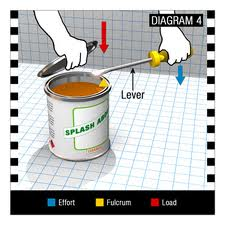Screwdrivers (Download)
Screwdrivers 1 Description A screwdriver is a hand tool for turning a screw, consisting of a handle attached to a long, narrow shank, usually of metal, which contains a tip that fits into the head of a screw. Source: “Screwdriver.” http://dictionary.reference.com/browse/screwdriver 2 Background Information : History The first screwdriver traces its roots to 15 th century Germany. First documented in The Medieval Housebook of Wolfegg Castle Originally called a “screw-turner” Originally used to secure armor and firearm parts Seen as a luxury tool due to expensive costs to produce screws The Industrial Revolution brought about rapid advances in manufacturing screws. Source: Rybczynski , Witold (2000), One Good Turn: A Natural History of the Screwdriver and the Screw, Toronto: Harper Flamingo Canada; pgs. 53-54 3 Background Information: Modern Advances 1907- Peter L. Robertson patented the first socket-headed screw and screwdriver. Gave way to the modern screwdriver 1936- Henry Phillips invented an improved form of the Robertson screw and screwdriver. Deep-socket screw and screwdriver with a cruciform known as the Phillips Screw and Phillips Screwdriver Still the most popular screw/screwdriver combination used today Source: Rybczynski, Witold (2000), One Good Turn: A Natural History of the Screwdriver and the Screw; pgs. 80-83 Close-up of a Robertson screw A modern Phillips screw 4 Background Information: Types of Screwdrivers Two widely used hand-held screwdrivers are today: Flathead Phillips-head Electric drills with Phillips-head and flathead drill bits can be used for faster installation/removal. Phillips-head Screwdriver Flathead Screwdriver Electric drill with Phillips-head drill bit attached 5 Components A screwdriver consists of four parts: 1 ) handle 2 ) shank 3 ) blade 4 ) tip Source: “Parts of a Screwdriver.” Toolmanship: How to use a Screwdriver. http://artofmanliness.com/2010/02/18/toolmanship-how-to-use-a-screwdriver/ 6 Standard Usage Tightening and loosening screws Different sizes and drive types are used by jewelers and gunsmiths. Flathead screwdrivers are often used for opening paint cans. Jeweler’s screwdriver set Flat-head screwdriver opening a paint can Gunsmith’s screwdriver set 7 Relevance to Construction Mainly used for tightening and loosening screws in wood framing, hanging drywall, cabinetry, etc . Use electric drills with Phillips-head and flathead drill bits for faster assembly . Use flathead screwdriver for opening paint cans. 8 Typical Hazards Improper use: Prying, punching, chiseling Incorrect size Incorrect type Usage around live conductors/circuits Using a damaged screwdriver Bent shank Broken tip Damaged handle Sources: Safety Hints: Screwdrivers. http://www.osh.dol.govt.nz/order/catalogue/archive/screwdrivers.pdf OSH Answers (Screwdrivers)- http://www.ccohs.ca/oshanswers/safety_haz/hand_tools/screwdrivers.html 9 Statistics Other There were 13 fatal OSHA cases involving screwdrivers between 1990-2009 9 of which the victim was electrocuted SOURCE: Extracted from OSHA Accident Investigation Data 1990-2009 10 Fatality Case involving a Screwdriver A worker was standing in front of the left side track of a Komat’su track dozer. He touched the contact points on the starter with a screwdriver. The machine was in forward high gear when the engine started and moved forward, crushing and killing him under the machine’s track. SOURCE: Extracted from OSHA Accident Investigation Data 1990-2009 A Komat’su Model D-31-E, similar to the track dozer which killed the worker. 11 Fatality Case involving a Screwdriver Two workers were installing three current transformers in an energized 480-volt , 800-amp panelboard. One worker used a screwdriver to connect the two halves of a current transformer around the bus bar when an electrical fault occurred. Both employees received second and third degree burns over 80% of their bodies as a result of the electric arc and explosion. One worker died and the other was hospitalized. SOURCE: Extracted from OSHA Accident Investigation Data 1990-2009 12 Fatality Case involving a Screwdriver Two workers were on an insulated aerial lift, removing a bolt from the top of a utility pole. One of the workers climbed out of the bucket and onto the cross arm, while the other stayed in the bucket. Using a hammer and a screwdriver, he punched the bolt until he could pull it out by hand. When he pulled the bolt free, his hand contacted an energized jumper. He received an electric shock and his clothing ignited. He died from his injuries. SOURCE: Extracted from OSHA Accident Investigation Data 1990-2009 Worker in an aerial lift working on utility pole 13 Fatality Case involving a Screwdriver A worker was standing on the rear of a conveyor-type boom truck. He was using a screwdriver to manipulate the boom controls since the joystick for the control was broken. As he rotated the boom, it contacted a 7200-volt overhead power line. He received an electric shock, descended from the truck bed, and died from the electrical shock. SOURCE: Extracted from OSHA Accident Investigation Data 1990-2009 Freightliner FL80 truck with bucket 14 Fatality Case involving a Screwdriver A company was moving a form traveler which was used for pouring concrete, when electrical power was lost to the machine. The superintendent decided to test the electrical system. The probes for the tester were not of sufficient length to reach into the cavity to make contact with the conductor. He inserted a screwdriver into the cavity which was used as an extension for the probe. He contacted the energized screwdriver with the back of his hand and was electrocuted. SOURCE: Extracted from OSHA Accident Investigation Data 1990-2009 15 Fatality Case involving a Screwdriver Two workers were helping to renovate a building by installing new electrical wiring. One worker had informed the other that one of the metal conduits was loose, and it was energizing the other conduits in the area. The worker entered the attic area with a voltage detector to identify any energized conduits or wires. SOURCE: Extracted from OSHA Accident Investigation Data 1990-2009 Greenlee GT-11 Voltage Detector, similar to the one used by the victim 16 Continued Klein Journeyman electrical gloves with thumbs, index and middle fingers exposed, similar to the gloves the victim was wearing. The worker had non-insulated tools (a screwdriver and a 9-inch side cutter), and he was wearing journeyman electrical gloves which did not cover two fingers and the thumb of each hand. As he was crawling in the limited attic space, his chest and upper extremities made contact with an energized conduit or wire, and he was electrocuted. SOURCE: Extracted from OSHA Accident Investigation Data 1990-2009 17 OSHA Regulations There is NO OSHA regulation pertaining specifically to screwdriver safety. However, 1910.335(a)(2)(i) states: “When working near exposed energized conductors or circuit parts, each employee shall use insulated tools or handling equipment if the tools or handling equipment might make contact with such conductors or parts.” This extends to the use of screwdrivers near live conductors/circuits. Source: OSHA Regulations (Standards-29 CFR). http://www.osha.gov/pls/oshaweb/owadisp.show_document?p_table=STANDARDS&p_id=9912 Screwdrivers with insulated handles 18 Personal Protective Equipment Use insulated gloves to avoid hand injuries. Use safety glasses when using an electric screwdriver. 19 Safety Procedures Always match the screwdriver to the screw head, both in terms of size and type. Use a screwdriver with a tip width that is the same width as the screw head. Keep the screwdriver handle clean. Greasy handles can cause injury from unexpected slippage. Do not lean or push on a screwdriver with any more force than necessary. Do not use defective screwdrivers. If work must be carried out on electronic equipment, use screwdrivers that have insulated handles. Source: OSH Answers (Screwdrivers)- http://www.ccohs.ca/oshanswers/safety_haz/hand_tools/screwdrivers.html 20 Safety Procedures Do not hold the screw stock in one hand while using the screwdriver with the other. Pre-drill screw holes when possible Slippage could cause serious injury to the hand, especially with electric screwdrivers. Do not use a screwdriver to check if an electrical circuit is live. Source: OSH Answers (Screwdrivers): http://www.ccohs.ca/oshanswers/safety_haz/hand_tools/screwdrivers.html 21 Work Safely Think Safety 22

